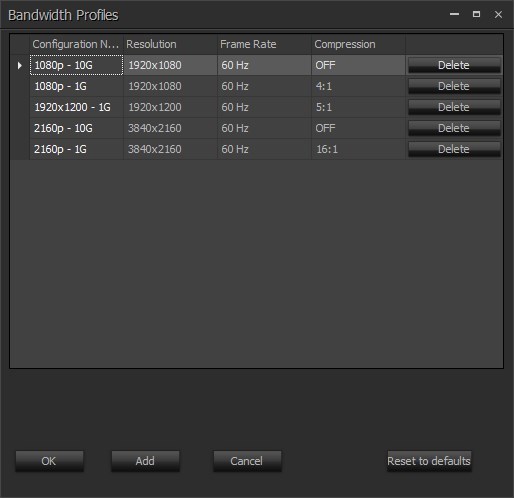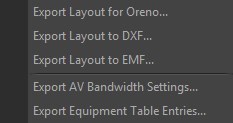File Menu

Icon |
Name |
Description |
|
New |
Begins a new Tesira® system design file (.TMF). The user may be asked to specify the Software Mode required. |
|
Open |
Opens an existing Tesira® system design file (.TMF). |
|
Save |
Saves the current Tesira® system design file (.TMF). The default file path is \My Documents\Biamp\Tesira\Datafiles\ |
|
Save As |
Saves the current Tesira® system design file (.TMF), with choice of directory location and file name. |
|
Save As Template |
Saves the current Tesira® system design file (.TMF) without equipment table and system information so it can be recalled later for use with another set of hardware. More details are available in the Using Templates section. |
|
Export |
Export Layout for Oreno - NOTE: this product has been deprecated and is no longer supported by Tesira software. Export Layout to DXF or Export Layout to EMF The active partition DSP layout will be saved to a .DXF (drawing interchange format) or .EMF (enhanced metafile file) format. Export AV Bandwidth Settings - Saves the bandwidth information used in the configuration to an .XML file. See below for further information on this feature. Export Equipment Table Entries - Saves device information shown in the Equipment Table to an .XML file. See below for further information on this feature. |
|
Opens a print dialog box, to adjust printer settings and print the Layout. The system layout and any/all partitions are available to print. |
|
|
Recent File |
Provides a list of recently saved files for convenient access. |
|
Exit |
Closes the Tesira® software program. Also provides prompt to save the current Tesira system design file if necessary. If a file is open during Exit, that file will automatically open at next session. |
Export AV Bandwidth Settings
AV Bandwidth Settings export as an XML or text format for easy import into common log viewer programs. The file can also be opened in spreadsheet programs such as Microsoft Excel.
The file exported will contain the following information:
- A list of AV Input blocks, the partition they are in, and their current bandwidth settings.
- A list of bandwidth profiles used in that document.
- A list of AV Output blocks, and the partition they are in.
- A list of streams that are potentially active.
Note the Export AV Bandwidth Settings feature will only be enabled if there are video partitions in the current document.
Example spreadsheet images shown here have been broken down in to their relevant sections for easy viewing, however these are all various extracts of one main exported AV Bandwidth .XML document.
Bandwidth Profiles
The bandwidth profile information will be all the profiles in the AV Input > To Network Tab > Bandwidth Profiles customization dialog.


| Entry Type | Message Information |
| originalFilename | Location and file name of .tmf file |
| exportDate | PC time and date of export |
| name | Assigned name of bandwidth profile |
| Resolution | Resolution of bandwidth profile |
| FrameRate | Frame rate of bandwidth profile |
| Compression | Rate of compression of bandwidth profile |
AV Input Information
The AV Input blocks section will contain a summary of all AV Input blocks in the file

| Entry Type | Message Information |
| objectID | Object ID of AV Input block |
| channel | Corresponding AV Input channel |
| Label | Label given to AV Input block within configuration file |
| Id | Which partition within the configuration file the AV Input block is located |
| Name2 | Name of partition where AV Input block is located |
| Type | Type of video partition (1 Gbps/10Gbps) |
| BandwidthProfile | Displays Bandwidth Profile of input The BandwidthProfile element will be empty if custom bandwidth settings are being used |
| Resolution3 | Current resolution of input |
| FrameRate4 | Current frame rate of input |
| Compression5 | Current compression rate of input |
| MaxBandwidth | Displays Maximum Bandwidth of input |
| BandwidthAlertThreshold | Threshold at which software will notify user their set bandwidth limit has been reached |
| MaxPossibleStreams | Max number of possible audio streams from AV Input block. There will be two streams for the AV port, and one for the aux audio port, regardless of whether it’s mono or stereo. |
| NumConnectedStreams | Current number of connected audio streams from AV Input block. |
AV Output block information
AV Output blocks have similar information as AV Input blocks, apart from Bandwidth settings which are absent from output blocks

| Entry Type | Message Information |
| objectID6 | Object ID of AV Output block |
| channel7 | Corresponding AV Output channel |
| Label8 | Label given to the AV Output block within configuration file |
| Id9 | Which partition within the configuration file the AV Output block is located |
| Name10 | Name of partition where AV Output block is located |
| Type11 | Type of video partition (1 Gbps/10Gbps) |
| MaxPossibleStreams12 | Max number of possible audio streams to AV Output block There will be two streams for the AV port, and one for the aux audio port, regardless of whether it’s mono or stereo. |
| NumConnectedStreams13 | Current number of audio streams connected to the AV Output block |
Stream Information
Each line segment that can potentially participate in a stream is listed.

| Entry Type | Message Information |
| Type14 | What type of media is being routed (audio/video) |
| blockType | Defines what AV block type is transmitting media |
| objectID15 | Object ID of AV block transmitting media |
| portIndex | Which output node of AV block is transmitting media |
| blockType16 | Defines what AV block type is receiving media |
| objectID17 | Object ID of AV block receiving media |
| portIndex18 | Which input node of AV block is receiving media |
Note that Split pass-through, PCTxVideo and PCRxVideo blocks are not included in the exported list as they act as pass-throughs to the next block.
Export Equipment Table Entries
The equipment table is used for seeing what hardware is assigned within a system and its related details. A report of the Equipment Table Entries exports as an XML or text format for easy import into common log viewer programs. The file can also be opened in spreadsheet programs such as Microsoft Excel.

| Entry Type | Message Information |
| ExportVersion | The version of Tesira software that was used to export the Equipment Table entries |
| ID | The unit number assigned to the device in the Equipment Table entry |
| DeviceModel | The model type of device |
| DeviceType | The class of device |
| HostName | The device’s Host Name |
| SerialNumber | The devices Serial Number |
| DeviceDescription | The devices current Description |
| InformationSource | The devices network status from the last device discovery. If the device can not be found on the network during the device discovery, this entry will advise that this is cached information and when the cached data was captured |
| FirmwareVersion | The devices firmware version |
| OperatingEnvironmentVersion | What operating environment is running within the Tesira device |
| IPV4Address | The device's interface current IP address |
| InterfaceID | The type of interface listed the IPV4Address field |
| InterfaceMACAddress | The physical MAC address of network port |
| InterfaceID2 | The interface being identified in the InterfaceMACAddress field |
| ProxyHostName | The hostname of the server acting as the proxy for the device (expanders only) |
| DeviceDescription | The unit’s device description if one has been assigned |
* Note that the XML output will only display the relevant columns to the type of device and information specified in the Equipment Table. For example, if there's no expander class devices listed in the Equipment Table at the time of Export, the ProxyHostName field will not be seen in the XML output file.




